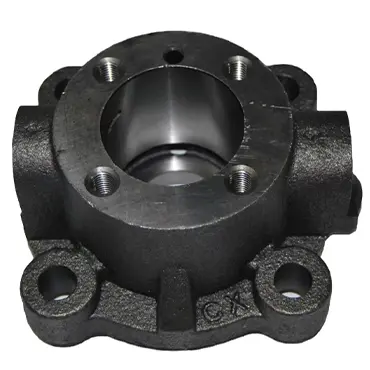Ductile iron surface decay defects causes and preventive measures
On the surface of ductile iron castings, especially in thick and large parts or hot spots of castings, the morphology of graphite nodules deteriorates. The originally regular and round spherical graphite gradually becomes irregular, and flake, worm-like or flocculent graphite may appear. At the same time, accompanied by changes in the matrix structure, the pearlite content decreases and the ferrite content increases, which reduces the surface hardness, strength and toughness of the casting, seriously affecting the mechanical properties and performance of the casting.
Causes
Loss of magnesium element: During the pouring and solidification process of the spheroidized molten iron, magnesium will react and gradually lose due to its strong affinity with elements such as oxygen and sulfur. On the surface of the molten iron, magnesium is more likely to react with oxygen in the air to form magnesium oxide, resulting in a decrease in the magnesium content on the surface of the molten iron, which makes it impossible to effectively maintain the conditions for graphite spheroidization and induce spheroidization decay. For example, during a long pouring process, the molten iron stays in the ladle for too long, and the oxidation loss of surface magnesium is aggravated.
Inoculation decay: The role of the inoculant is to further promote graphitization and refine graphite nodules after spheroidization. However, the inoculation effect will gradually weaken over time, that is, inoculation decay. When inoculation decay occurs, the growth of graphite nodules cannot be well controlled, and poor spheroidization is prone to occur. For example, when the temperature of the molten iron is high and the amount of inoculant added is insufficient or the particle size of the inoculant is not appropriate, the duration of the inoculation effect will be greatly shortened.
Unreasonable design of the pouring system: If the pouring system cannot fill the mold cavity with molten iron smoothly and quickly, it will cause oxidation and uneven temperature drop of the molten iron during the flow in the mold cavity. For example, if the pouring speed is too slow, the molten iron flows in the mold cavity for a long time, the surface oxide scale increases, and the heat loss is large, which makes the temperature and composition of the molten iron uneven, and the spheroidization conditions in the local area deteriorate, which leads to spheroidization decay.
Influence of casting conditions: Factors such as the permeability, moisture content, and coating of the mold have an impact on the spheroidization effect of ductile iron. If the mold has poor air permeability, the gas generated by the molten iron during the solidification process cannot be discharged smoothly, which will form ductile iron surface decay defects such as pores on the surface of the casting, and may also destroy the stability of graphite spheroidization; if the mold has a high moisture content, a large amount of water vapor will be generated under the action of high-temperature molten iron, which will accelerate the loss of magnesium and lead to spheroidization decay. For example, if the green sand mold is not fully dried, the spheroidization decay caused by moisture is likely to occur during pouring.
Preventive measures
Optimize the spheroidization and inoculation process: strictly control the amount, method and treatment time of the spheroidizer and inoculant. Use a suitable subcontracting process or flushing process to ensure that the spheroidizer and inoculant are evenly dispersed in the molten iron, and pour as soon as possible after treatment to reduce the loss of magnesium and inoculation effect. For example, when using subcontracting, it is necessary to ensure that the subcontract has good sealing to reduce the volatilization of magnesium.
Improve the design of the pouring system: design a reasonable pouring system to ensure that the molten iron can fill the mold smoothly and quickly. Use a bottom pouring system or a stepped pouring system to reduce the oxidation and temperature loss of the molten iron. At the same time, reasonably set the size and number of the pouring ports, control the pouring speed, and make the molten iron rise evenly in the mold cavity. For example, for large ductile iron castings, a stepped pouring system with multiple gates can effectively improve the pouring quality.
Improve casting conditions: To improve the air permeability of the mold, you can add an appropriate amount of breathable materials such as sawdust to the sand; strictly control the moisture content of the mold, and fully dry the wet sand mold; select a suitable mold coating, the coating should have good high temperature resistance and air isolation, reduce the interaction between the molten iron and the mold, and reduce the risk of spheroidization decay. For example, the use of alcohol-based coatings can form a dense protective film on the surface of the mold after drying, which is conducive to the casting and molding of ductile iron.
What effects will the spheroidization ductile iron surface decay defects have on the quality of castings?
Mechanical properties
Reduced strength: Ductile iron with good spheroidization has little cutting effect on the matrix, low stress concentration, and can effectively transfer loads, making the castings stronger. After spheroidization declines, the graphite morphology deteriorates. For example, the presence of flake or worm-like graphite will increase the stress concentration on the matrix, resulting in a decrease in the tensile strength and bending strength of the casting. For example, the tensile strength of normal ductile iron can reach 400-900MPa. After spheroidization declines, the strength may decrease by 30%-50%.
Deterioration of toughness: Toughness is mainly reflected in the ability of castings to resist impact and deformation without damage. Spheroidization decline causes graphite spheres to lose their roundness. When impacted by external forces, cracks are more likely to initiate and expand at the interface between graphite and the matrix. Ductile iron, which originally has good toughness, may have its impact toughness greatly reduced due to spheroidization decline. For example, the impact toughness can reach 10-30J/cm² when spheroidization is normal, but it may drop to 3-10J/cm² after decline.
Hardness change: Generally, spheroidization decay will lead to a decrease in the surface hardness of the casting. This is because spheroidization decay is often accompanied by an increase in the ferrite content in the matrix structure and a relative decrease in the pearlite content. The low hardness of ferrite reduces the overall hardness of the casting, affecting its wear resistance and other properties.
Physical properties
Density reduction: After spheroidization decay, the graphite morphology becomes irregular, and its volume in the casting increases relatively, while the relative volume of the iron matrix decreases. Because the density of graphite is lower than that of the iron matrix, the overall density of the casting will decrease, which may affect the use of the casting in some application scenarios that require weight or density.
Thermal conductivity decreases: The thermal conductivity of ductile iron with good spheroidization is mainly affected by the matrix structure and graphite distribution. After spheroidization decay, the distribution of graphite becomes uneven and irregular, which interferes with the heat conduction path and makes the thermal conductivity of the casting worse. In applications that require good heat dissipation, such as engine blocks, reduced thermal conductivity may cause local overheating and affect its normal use.
Appearance and dimensional accuracy
Poor surface quality: Spheroidization recession may cause the surface of the casting to be rough and uneven. This is because irregular graphite growth will make the microstructure of the casting surface messy, and it is difficult to obtain an ideal surface finish during machining or surface treatment.
Dimensional accuracy is affected: During the casting process, the uneven solidification shrinkage caused by spheroidization recession will make the dimensional accuracy of the casting difficult to control. For example, when making high-precision mechanical parts, the parts may be scrapped because the dimensional deviation exceeds the allowable range.





